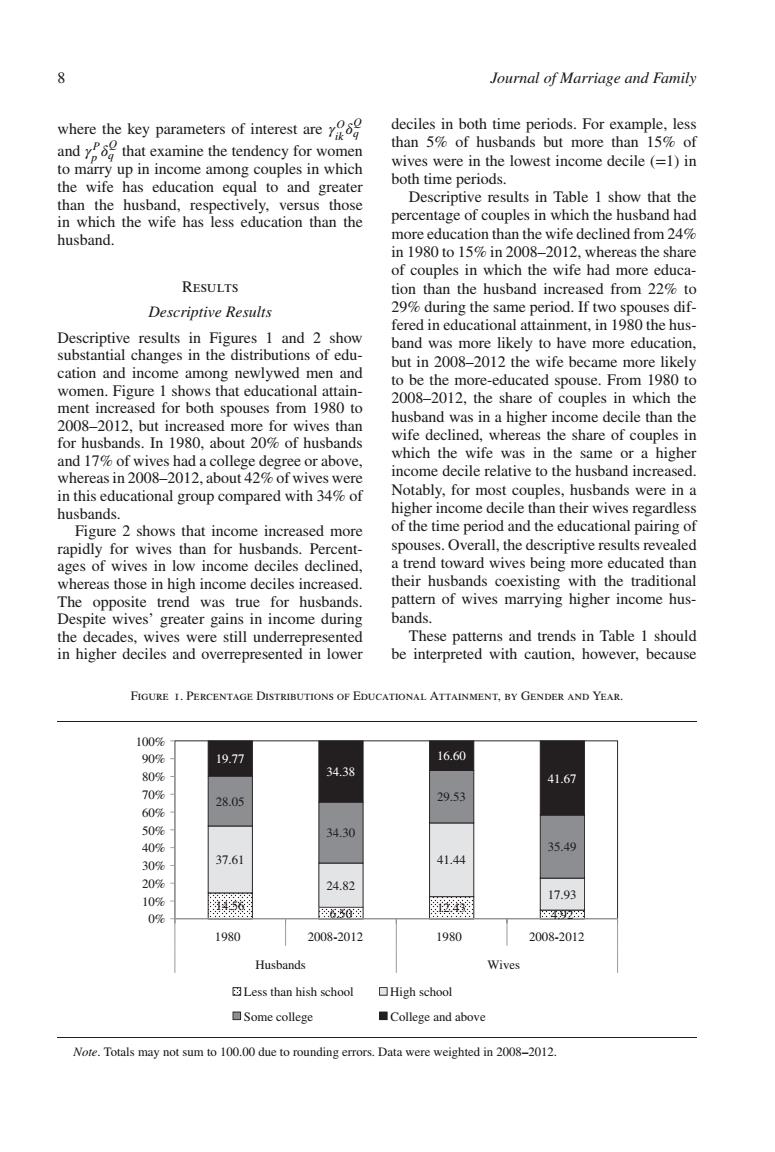正在加载图片...

8 Journal of Marriage and Family where the key parameters of interest are deciles in both time periods.For example,less and that examine the tendency for women than 5%of husbands but more than 15%of to marry up in income among couples in which wives were in the lowest income decile (=1)in the wife has education equal to and greater both time periods. Descriptive results in Table 1 show that the than the husband,respectively.versus those in which the wife has less education than the percentage of couples in which the husband had husband. more education than the wife declined from 24% in 1980 to 15%in 2008-2012,whereas the share of couples in which the wife had more educa- RESULTS tion than the husband increased from 22%to Descriptive Results 29%during the same period.If two spouses dif- fered in educational attainment,in 1980 the hus- Descriptive results in Figures 1 and 2 show band was more likely to have more education, substantial changes in the distributions of edu- but in 2008-2012 the wife became more likely cation and income among newlywed men and to be the more-educated spouse.From 1980 to women.Figure I shows that educational attain- 2008-2012,the share of couples in which the ment increased for both spouses from 1980 to 2008-2012,but increased more for wives than husband was in a higher income decile than the for husbands.In 1980,about 20%of husbands wife declined,whereas the share of couples in and 17%of wives had a college degree or above, which the wife was in the same or a higher whereas in 2008-2012,about 42%of wives were income decile relative to the husband increased. in this educational group compared with 34%of Notably,for most couples,husbands were in a husbands. higher income decile than their wives regardless Figure 2 shows that income increased more of the time period and the educational pairing of rapidly for wives than for husbands.Percent- spouses.Overall,the descriptive results revealed ages of wives in low income deciles declined. a trend toward wives being more educated than whereas those in high income deciles increased. their husbands coexisting with the traditional The opposite trend was true for husbands. pattern of wives marrying higher income hus- Despite wives'greater gains in income during bands. the decades,wives were still underrepresented These patterns and trends in Table 1 should in higher deciles and overrepresented in lower be interpreted with caution,however,because FIGURE I.PERCENTAGE DISTRIBUTIONS OF EDUCATIONAL ATTAINMENT.BY GENDER AND YEAR. 100% 90% 19.77 16.60 80% 34.38 41.67 70% 28.05 29.53 60% 50% 34.30 40% 35.49 30% 37.61 41.44 20% 24.82 10% 17.93 0% 险0网 498 1980 2008-2012 1980 2008-2012 Husbands Wives Less than hish school ▣High school ☐Some college ■College and above Note.Totals may not sum to 100.00 due to rounding errors.Data were weighted in 2008-2012.8 Journal of Marriage and Family where the key parameters of interest are 𝛾O ik 𝛿Q q and 𝛾P p 𝛿Q q that examine the tendency for women to marry up in income among couples in which the wife has education equal to and greater than the husband, respectively, versus those in which the wife has less education than the husband. Results Descriptive Results Descriptive results in Figures 1 and 2 show substantial changes in the distributions of education and income among newlywed men and women. Figure 1 shows that educational attainment increased for both spouses from 1980 to 2008–2012, but increased more for wives than for husbands. In 1980, about 20% of husbands and 17% of wives had a college degree or above, whereas in 2008–2012, about 42% of wives were in this educational group compared with 34% of husbands. Figure 2 shows that income increased more rapidly for wives than for husbands. Percentages of wives in low income deciles declined, whereas those in high income deciles increased. The opposite trend was true for husbands. Despite wives’ greater gains in income during the decades, wives were still underrepresented in higher deciles and overrepresented in lower deciles in both time periods. For example, less than 5% of husbands but more than 15% of wives were in the lowest income decile (=1) in both time periods. Descriptive results in Table 1 show that the percentage of couples in which the husband had more education than the wife declined from 24% in 1980 to 15% in 2008–2012, whereas the share of couples in which the wife had more education than the husband increased from 22% to 29% during the same period. If two spouses differed in educational attainment, in 1980 the husband was more likely to have more education, but in 2008–2012 the wife became more likely to be the more-educated spouse. From 1980 to 2008–2012, the share of couples in which the husband was in a higher income decile than the wife declined, whereas the share of couples in which the wife was in the same or a higher income decile relative to the husband increased. Notably, for most couples, husbands were in a higher income decile than their wives regardless of the time period and the educational pairing of spouses. Overall, the descriptive results revealed a trend toward wives being more educated than their husbands coexisting with the traditional pattern of wives marrying higher income husbands. These patterns and trends in Table 1 should be interpreted with caution, however, because Figure 1. Percentage Distributions of Educational Attainment, by Gender and Year. Some college College and above 14.56 6.50 12.43 4.92 37.61 24.82 41.44 17.93 28.05 34.30 29.53 19.77 35.49 34.38 16.60 0% 41.67 10% 20% 30% 40% 50% 60% 70% 80% 90% 100% 1980 19 2008-2012 200 80 8-2012 Husbands Wives Less than hish school High school Note. Totals may not sum to 100.00 due to rounding errors. Data were weighted in 2008–2012